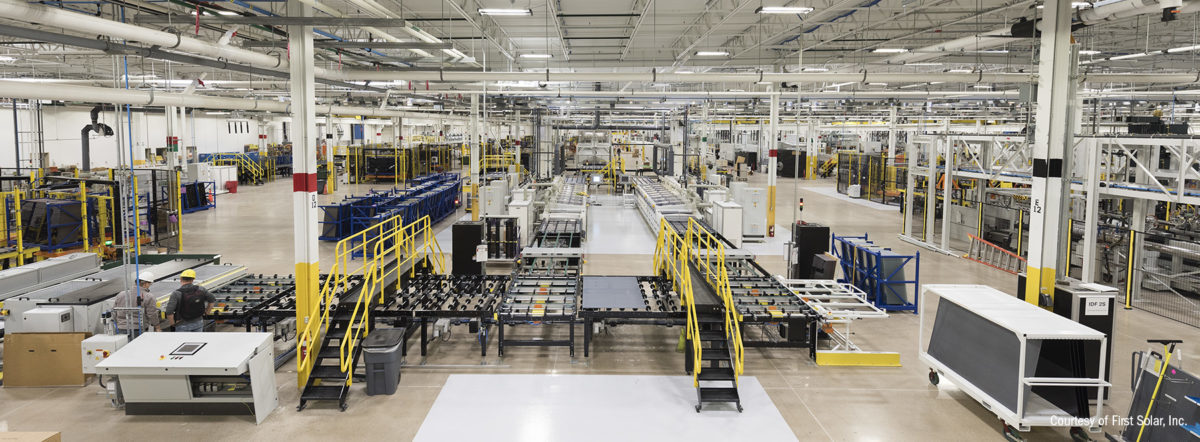From pv magazine USA
Over the past two years, First Solar has taken on the biggest change of its decades as a solar manufacturer: the re-tooling of its factories to make its large-format Series 6 modules. And if Q2 was the nadir of this process, with several factories either retooling or under construction and losses based on limited sales, the company’s Q3 results sees First Solar successful executing on the ramping of the Series 6, and a return to profitability.
Earlier this month, First Solar began commercial production of its Series 6 at the first of its twin factories in Vietnam, which follows on the start of production in its legacy Ohio factory as well as in Kulim, Malaysia earlier this year. The Vietnam factory is already up to 35% throughput, with Malaysia producing at 75% and the Perrysburg, Ohio factory rising to 90%.

And there is plenty of demand for this output. First Solar signed contracts to deliver an additional 1.1 GW-DC of modules since its last earnings call, bringing its bookings to a massive 11.3 GW. While meeting this demand will depend on the timing of ramping production, First Solar CEO Mark Widmar estimates that the company is sold out through 2020.
And as First Solar gets more modules produced and shipped, revenues are coming back. During Q3 revenues more than doubled to $676 million, and more centrally the company’s operating margin came back from the red to 8.7%.

Looking forward First Solar is ahead of schedule with getting production online, and says that due to faster than expected progress at the second Vietnam factory it will begin production in the first quarter of 2019, instead of the second quarter.
CEO Widmar also notes that construction of the company’s new 1.2 GW factory in Ohio is proceeding on schedule. In 2020 when all factories are completed and ramped the company expects to have 7.6 GW of annual manufacturing capacity.
Competition
Popular content
First Solar’s success in ramping comes as PV module prices are collapsing both globally and in the United States due to a global oversupply resulting from Chines policy changes. The company claims to have very low costs for S6 in greenfield factories, in part due to improved efficiency in recent years, but no PV manufacturer is unaffected by price dynamics.
“I understand pricing in some markets is very aggressive,” admitted CEO Widmar. However, he remained positive and referenced the company’s enormous and growing backlog. “We’re booking good economics with good customers,” stated Widmar.
This does not mean that some deals don’t fall through. Widmar referenced a situation where one Chinese customer cancelled its purchase, forfeiting a 20% deposit, and he clarified that the company will enforce its contractual rights.
At the end of the day First Solar’s massive backlog leaves room for some cancellation. Nor is this backlog coming from captive projects, as in previous years. Widmar estimates that 80% of First Solar’s current backlog comes from module sales, not projects that the company is developing.
In fact, going forward First Solar expects its systems business to total only 1 GW annually. But this does not mean that the company is not involved after the modules are shipped. Widmar noted a 650 MW module deal with Tampa Electric that expanded to a engineering, procurement and construction (EPC) agreement, and First Solar will also provide operations and maintenance services on the projects that it will construct.
On a similar vein, First Solar is providing EPC services on a 200 MW-AC solar project that it recently sold to Origis Energy in Georgia, which represents the 2nd-largest solar project in the U.S. South.
First Solar still sees much of its opportunities in the U.S. market, and referenced the South and Mid-Atlantic on the call. With the recent 500 MW RFP for wind and solar in Virginia and ongoing opportunities in several other states in the South, it appears that this region will be important for many manufacturers, including First Solar.
The company brought down its guidance slightly due to timing of project completion, but still expects $2.3 – $2.4 billion in 2018 revenues, and a total operating margin in the 4-5% range, while shipping 2.6-2.7 GW of modules.

This content is protected by copyright and may not be reused. If you want to cooperate with us and would like to reuse some of our content, please contact: editors@pv-magazine.com.


By submitting this form you agree to pv magazine using your data for the purposes of publishing your comment.
Your personal data will only be disclosed or otherwise transmitted to third parties for the purposes of spam filtering or if this is necessary for technical maintenance of the website. Any other transfer to third parties will not take place unless this is justified on the basis of applicable data protection regulations or if pv magazine is legally obliged to do so.
You may revoke this consent at any time with effect for the future, in which case your personal data will be deleted immediately. Otherwise, your data will be deleted if pv magazine has processed your request or the purpose of data storage is fulfilled.
Further information on data privacy can be found in our Data Protection Policy.